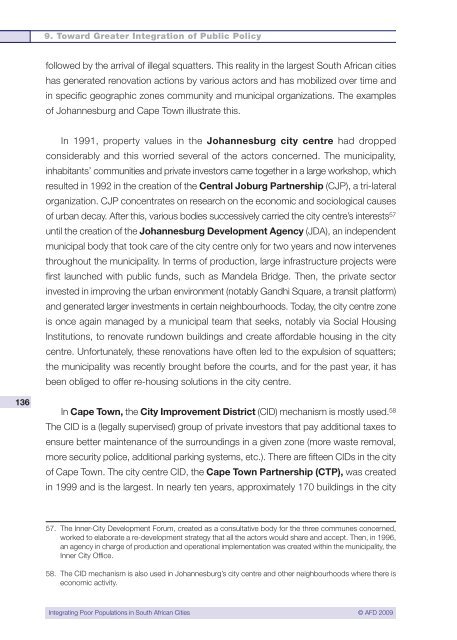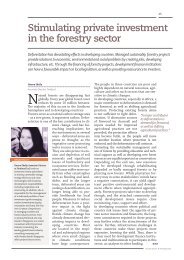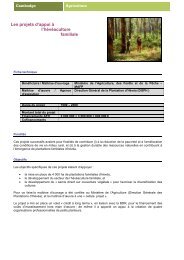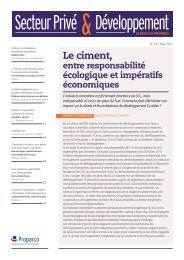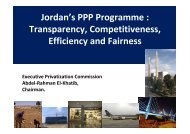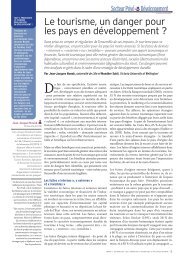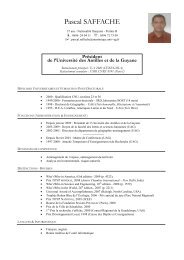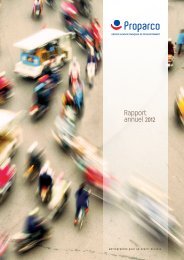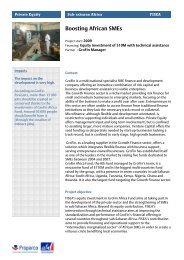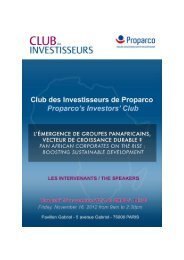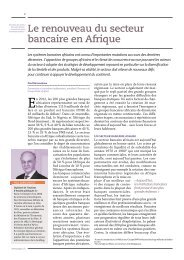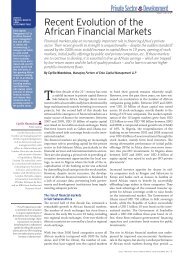Integrating Poor Populations in South African Cities - Agence ...
Integrating Poor Populations in South African Cities - Agence ...
Integrating Poor Populations in South African Cities - Agence ...
Create successful ePaper yourself
Turn your PDF publications into a flip-book with our unique Google optimized e-Paper software.
9. Toward Greater Integration of Public Policy<br />
followed by the arrival of illegal squatters. This reality <strong>in</strong> the largest <strong>South</strong> <strong>African</strong> cities<br />
has generated renovation actions by various actors and has mobilized over time and<br />
<strong>in</strong> specific geographic zones community and municipal organizations. The examples<br />
of Johannesburg and Cape Town illustrate this.<br />
In 1991, property values <strong>in</strong> the Johannesburg city centre had dropped<br />
considerably and this worried several of the actors concerned. The municipality,<br />
<strong>in</strong>habitants’ communities and private <strong>in</strong>vestors came together <strong>in</strong> a large workshop, which<br />
resulted <strong>in</strong> 1992 <strong>in</strong> the creation of the Central Joburg Partnership (CJP), a tri-lateral<br />
organization. CJP concentrates on research on the economic and sociological causes<br />
of urban decay. After this, various bodies successively carried the city centre’s <strong>in</strong>terests 57<br />
until the creation of the Johannesburg Development Agency (JDA), an <strong>in</strong>dependent<br />
municipal body that took care of the city centre only for two years and now <strong>in</strong>tervenes<br />
throughout the municipality. In terms of production, large <strong>in</strong>frastructure projects were<br />
first launched with public funds, such as Mandela Bridge. Then, the private sector<br />
<strong>in</strong>vested <strong>in</strong> improv<strong>in</strong>g the urban environment (notably Gandhi Square, a transit platform)<br />
and generated larger <strong>in</strong>vestments <strong>in</strong> certa<strong>in</strong> neighbourhoods. Today, the city centre zone<br />
is once aga<strong>in</strong> managed by a municipal team that seeks, notably via Social Hous<strong>in</strong>g<br />
Institutions, to renovate rundown build<strong>in</strong>gs and create affordable hous<strong>in</strong>g <strong>in</strong> the city<br />
centre. Unfortunately, these renovations have often led to the expulsion of squatters;<br />
the municipality was recently brought before the courts, and for the past year, it has<br />
been obliged to offer re-hous<strong>in</strong>g solutions <strong>in</strong> the city centre.<br />
136<br />
In Cape Town, the City Improvement District (CID) mechanism is mostly used. 58<br />
The CID is a (legally supervised) group of private <strong>in</strong>vestors that pay additional taxes to<br />
ensure better ma<strong>in</strong>tenance of the surround<strong>in</strong>gs <strong>in</strong> a given zone (more waste removal,<br />
more security police, additional park<strong>in</strong>g systems, etc.). There are fifteen CIDs <strong>in</strong> the city<br />
of Cape Town. The city centre CID, the Cape Town Partnership (CTP), was created<br />
<strong>in</strong> 1999 and is the largest. In nearly ten years, approximately 170 build<strong>in</strong>gs <strong>in</strong> the city<br />
57. The Inner-City Development Forum, created as a consultative body for the three communes concerned,<br />
worked to elaborate a re-development strategy that all the actors would share and accept. Then, <strong>in</strong> 1996,<br />
an agency <strong>in</strong> charge of production and operational implementation was created with<strong>in</strong> the municipality, the<br />
Inner City Office.<br />
58. The CID mechanism is also used <strong>in</strong> Johannesburg’s city centre and other neighbourhoods where there is<br />
economic activity.<br />
<strong>Integrat<strong>in</strong>g</strong> <strong>Poor</strong> <strong>Populations</strong> <strong>in</strong> <strong>South</strong> <strong>African</strong> <strong>Cities</strong> © AFD 2009


